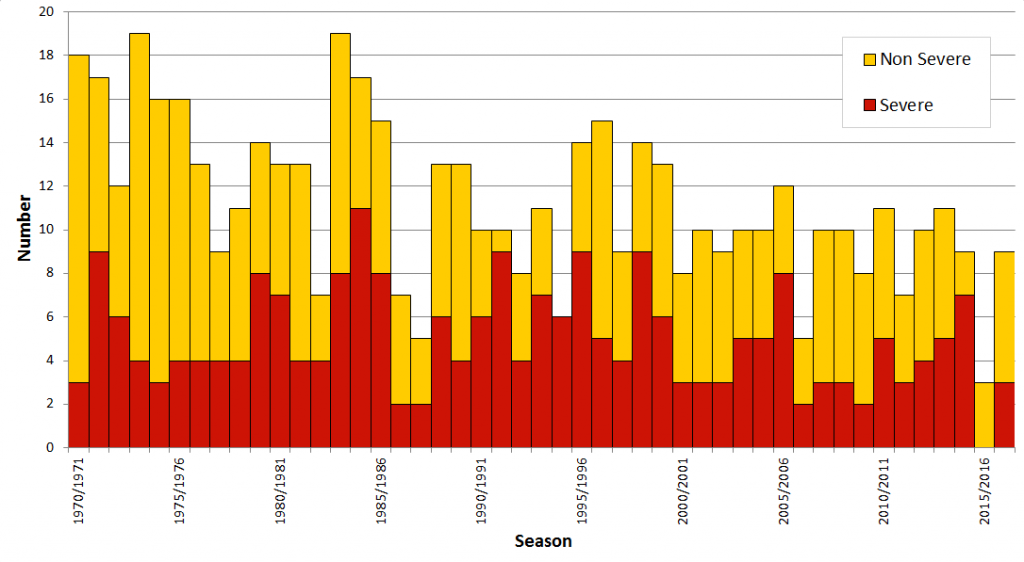Tropische Wirbelstürme haben die Menschen seit jeher geplagt. Im Folgenden wollen wir die Aktivitätsmuster des Pazifikraums beleuchten. Toomey et al. 2016 untersuchten die Wirbelsturmaktivität im Südpazifik für die vergangenen 3000 Jahre. Fazit: In der Zeit von 2600 bis 1500 Jahre vor heute waren die Stürme am schlimmsten. Auszug aus der Kurzfassung:
Our companion record of tropical cyclone activity from Tahaa suggests major storm activity was higher between 2600-1500 years B.P., when decadal scale SPCZ variability may also have been stronger. A transition to lower storm frequency and a shift or expansion of the SPCZ [South Pacific Convergence Zone] toward French Polynesia around 1000 years B.P. may have prompted Polynesian migration into the central Pacific.
Im westlichen Nordpazifik hat man nun herausbekommen, dass die Wirbelsturmtätigkeit überraschenderweise stark an den atantischen Ozeanzyklus der AMO gekoppelt ist. Zhang et al. berichteten im Februar 2018:
Dominant Role of Atlantic Multidecadal Oscillation in the Recent Decadal Changes in Western North Pacific Tropical Cyclone Activity
Over the 1997–2014 period, the mean frequency of western North Pacific (WNP) tropical cyclones (TCs) was markedly lower (~18%) than the period 1980–1996. Here we show that these changes were driven by an intensification of the vertical wind shear in the southeastern/eastern WNP tied to the changes in the Walker circulation, which arose primarily in response to the enhanced sea surface temperature (SST) warming in the North Atlantic, while the SST anomalies associated with the negative phase of the Pacific Decadal Oscillation in the tropical Pacific and the anthropogenic forcing play only secondary roles. These results are based on observations and experiments using the Geophysical Fluid Dynamics Laboratory Forecast-oriented Low-ocean Resolution Coupled Climate Model coupled climate model. The present study suggests a crucial role of the North Atlantic SST in causing decadal changes to WNP TC frequency.
Noch im September 2017 hatten Takahashi et al. angenommen, dass hier die Sulfat-Aerosol-Emissionen eine Rolle spielen könnten. Die jetzt von Zhang et al. vorgebrachte Erklärung über die AMO macht vermutlich mehr Sinn, da die Ozeanzyklen als Klimafaktor weiter an Bedeutung in der Attribution der beobachteten natürlichen Klimavariabilität gewinnen.
Gehen wir jetzt nach Australien. Dowdy 2014 zeigte, dass die Häufigkeit der tropischen Wirbelstürme hier abgenommen hat. Zudem scheint der Einfluss von El Nino variabel zu sein. Das bestätigt auch eine Graphik des australischen Bureau of Meteorology:

Abbildung: Graph showing the number of severe and non-severe tropical cyclones from 1970-2017 which have occurred in the Australian region. Severe tropical cyclones are shown here as those with a minimum central pressure less than 970 hPa. Quelle: Bureau of Meteorology
Haig & Nott 2016 untersuchten die Entwicklung der australischen tropischen Wirbelstürme während der vergangenen 1500 Jahre und fanden dabei einen Einfluss durch solare Aktivitätsschwankungen:
Solar forcing over the last 1500 years and Australian tropical cyclone activity
Accurate seasonal and decadal predictions of tropical cyclone activity are essential for the development of mitigation strategies for the 2.7 billion residents living within cyclone prone regions. The traditional indices (Southern Oscillation Index and various sea surface temperature indices) have fallen short in recent years as seasonal predictors within the Australian region. The short length of these records (i.e., <50 years) has meant that our current knowledge of larger-scale drivers at interdecadal, centennial, and millennial scales is limited. The development of a new tropical cyclone activity index spanning the last 1500 years has enabled the examination of tropical cyclone climatology at higher temporal resolution than was previously possible. Here we show that in addition to other well-known climate indices, solar forcing largely drives decadal, interdecadal, and centennial cycles within the tropical cyclone record.